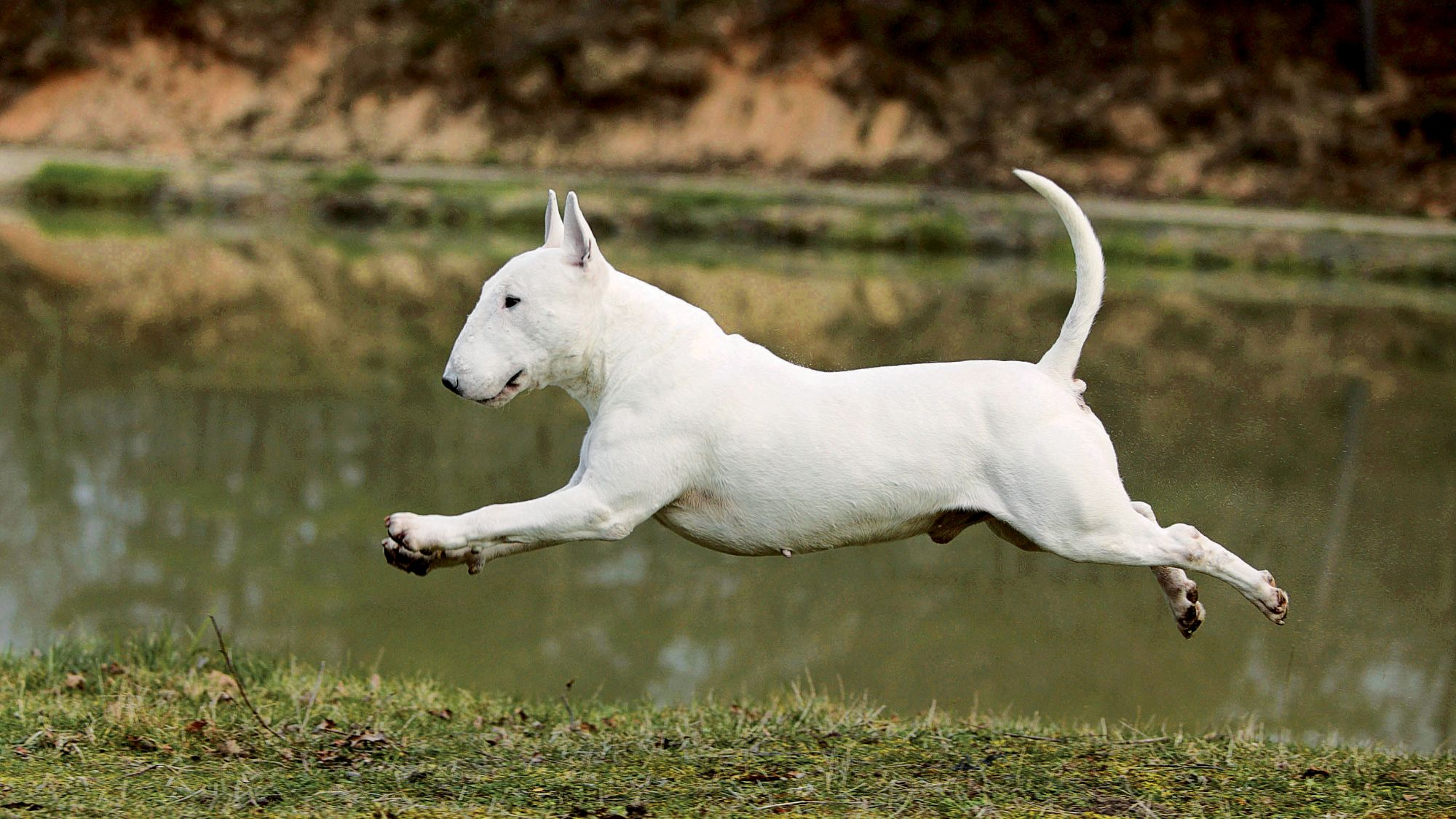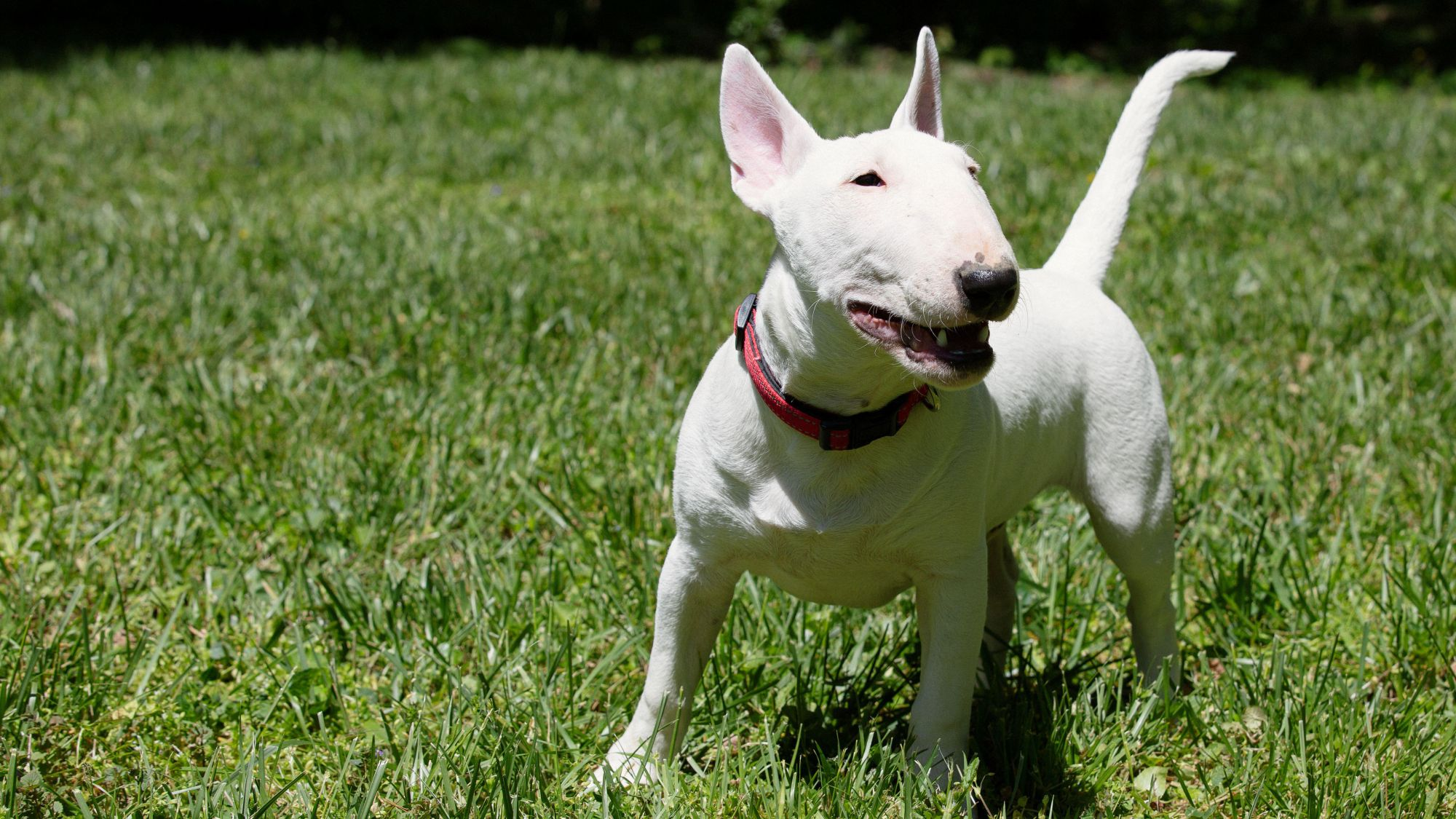
Let's talk Bull Terriers
The Bull Terrier lives up to the canine moniker of ‘(wo)man’s best friend’. They welcome anyone and everyone with open paws, making them a faithful and affectionate companion. You will find the Bull Terrier wherever the action is, as they like to stay busy and as close as possible to their people. Their intelligence makes the Bull Terrier a fantastic playmate and with consistent training, the Bull Terrier is a welcome addition to the family unit, capable of getting on very well with children.Official name: Bull Terrier
Other names: English Bull Terrier, Bully
Origins: United Kingdom

| Drooling tendencies |
|
Warm weather? |  |
| Shedding level | Suited to apartment living? |  |
|
| Energy level (high, low, medium) *: | Medium | Family pet? * |
|
| Compatibility with other pets |  |
Can stay alone?* | 
|
* We advise against leaving pets alone for long stretches. Companionship can prevent emotional distress and destructive behaviour. Speak to your veterinarian for recommendations.
Every pet is different, even within a breed; this snapshot of this breed’s specifics should be taken as an indication.
For a happy, healthy and well-behaved pet, we recommend educating and socialising your pet as well as covering their basic welfare, social and behavioural needs.
Pets should never be left unsupervised with a child.
All domestic pets are sociable and prefer company. However, they can be taught to cope with solitude from an early age. Seek the advice of your veterinarian or trainer to help you do this.


| Baby age: | Birth to 2 months |
| Puppy age: | 2 to 12 months |
| Adult age: | 1 to 7 years |
| Mature age: | 7 to 10 years |
| Senior age: | 10 years onwards |

1/7
Get to know the Bull Terrier
All you need to know about the breed
There is never a dull moment with a Bull Terrier around. Friendly. High energy. Loyal. They are a charming breed, who also like to play the class clown from time to time. With their unique egg-shaped head, they have won hearts many times over.
Active types need only apply! Exercise for your Bull Terrier should be between 30 and 60 minutes per day, and they excel when given fun tasks such as flyball or agility exercises. The Bull Terrier suits a confident owner, who will be firm and constant in their approach to training, taking the breed’s stubborn streak in their stride. Overall, teaching your Bull Terrier should be a pleasant experience for both parties, as the breed learns quickly and likes to please their owners.
The Bull Terrier much prefers to be around people and does not do well if left to their own devices. Early socialisation makes for a super sociable canine, who is great at being a guard dog, and feels comfortable in a crowd.
The Bull Terrier is always down to play, which makes them great company for older children who show them respect. Younger children however may find the breed a little too boisterous—they never mean any harm but just get over excited when the fun happens. However, if you’re looking for an affectionate and loving canine companion and enjoy a good amount of daily exercise, then the Bull Terrier may well be the breed for you.

2/7
2 facts about Bull Terriers
1. Mister Lonely
A Bull Terrier prefers company, so this is not the breed for you if work involves travel or long days away from home. If left to entertain themselves, they are likely to eat anything they can sink their teeth into. A Bull Terrier will not expect your undivided attention 24/7, they just love being around people! Social butterflies, if you will.
2. More exercise please
Exercising a Bull Terrier is not just physical, they also need their minds to stay sharp on a daily basis. Take your Bull Terrier for a jog or a long walk – always on a leash to prevent them wandering off – but also buy them interactive toys that will work their brain cells. The Bull Terrier will expend their energy in whatever way paw-sible, so the more entertaining you make it for them, the more devoted they will be to you.
History of the breed
Let’s rewind to 1835, when the Bull Terrier first appeared on the scene. A cross between a Bulldog and an English Terrier (now extinct), the Bull Terrier was known for its strength and success in the dog-fighting ring.
In 1860, an Englishman named James Hinks set out to create a white coated Bull Terrier, which set a new trend. Suddenly the breed became the must-have companion of distinguished gentlemen throughout England. This led to them being nicknamed “White Cavalier”, because of their dignified manner towards people while also being ferocious in the ring.
Happily, dog-fighting is now a thing of the past but the Bull Terrier remains as sweet and friendly as ever—with a silly side to boot that they’re not afraid to reveal. The American Kennel Club (AKC) first registered the breed in 1885, with a Bull Terrier named Nellie II. In 1936, the coloured Bull Terrier variety was officially recognised, and more recently, in 1992, the Miniature Bull Terrier was recorded as a separate breed.
Much like their distant relatives, the American Staffordshire Terrier and the Staffordshire Bull Terrier, many still believe the Bull Terrier of today to be some sort of canine gladiator. Brave, yes. Likes to stay active, also yes. But in reality, the Bull Terrier makes for an affectionate and loyal companion—for life.

4/7
From head to tail
Physical characteristics of Bull Terriers
1. الأذنان
آذان مرنة ولكن ليست ثقيلة تتدلى بجانب رأس الكلب
2. الشعر
شعر قصير وكثيف فوق طبقة سفلية مقاومة للماء
3. الفراء
فراء يتراوح بين الأسود إلى لون الشوكولاتة أو الأصفر، ومن الكريمي الفاتح إلى المحمر
4. الذيل
ذيل منتصب وهو بطبيعته طويل ونادرًا ما يتوقف عن الاهتزاز – والجسم كله يمكن يهتز في بعض الأحيان.
5. الساقان والعمود الفقري
متناسب بشكل جيد، مع توازن جيد بين طول الساق والعمود الفقري.

5/7
Things to look out for
From specific breed traits to a general health overview, here are some interesting facts about your Bull Terrier

6/7
Caring for your Bull Terrier
Grooming, training and exercise tips
Grooming your Bull Terrier is a delight, much like the breed itself. One weekly brush of their short coat is enough to keep them looking sleek. Check the ears regularly for dirt or wax, brush teeth, and trim nails frequently. When it comes to exercising your Bull Terrier, daily sessions of half an hour to an hour are required. Take them with you on a long walk and pop a ball in your pocket. The sporting ancestry of the Bull Terrier also makes them great at obedience, tracking and agility exercises. Be patient and firm when training a Bull Terrier. The key is to make training sessions fun, with a capital F—they will do most things so long as it doesn’t feel like a chore. Even after being trained, the Bull Terrier should be kept on a leash around other dogs, due to their high prey drive.7/7
All about Bull Terriers
100% yes. The Bull Terrier is an affectionate dog, who is capable of being equally devoted to all family members. The Bull Terrier also has a mischievous side, which makes them an entertaining companion, and they’re content to tire themselves out playing with older children. Teaching the Bull Terrier good social skills from when they are a puppy will result in a placid companion who is loyal until the very end.
When it comes to protecting the ones that they love, the Bull Terrier is top of the class. The breed’s muscular physique is often enough of a deterrent for wannabe burglars, especially when coupled with their loud bark, which the Bull Terrier rarely uses. A word of warning, the Bull Terrier’s natural protective instincts should not be developed any further—keep the breed a lover, not a fighter.
Read more on this topic


How to adopt a dog

Things to consider before getting a dog
Sources
1 - Veterinary Centers of America https://vcahospitals.com/
2 - Royal Canin Dog Encyclopaedia. Ed 2010 and 2020
3 - Banfield Pet Hospital https://www.banfield.com/
4 - Royal Canin BHN Product Book
5 - American Kennel Club https://www.akc.org/
